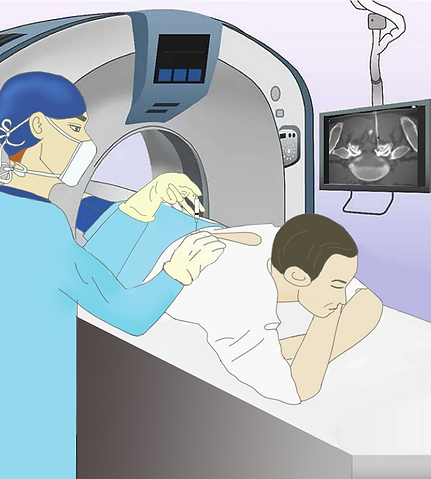Suite 407, San Clinic, Sydney Adventist Hospital, 185 Fox Valley Road, Wahroonga 2076
Tel: 02-9480-8728
What is a Facet Joint Injection?
The facet joints are at the back of the spinal column, allowing forward and backward bending, slight rotation, and tilting. Arthritis or strain of the facet joints may lead to back pain, and referred pain in the buttock, hip, groin, and leg.
Injection of corticosteroid may alleviate the pain by reducing inflammation. Injection with local anaesthetic agent may help to localise the source of pain and provides temporary relief before the effect of the steroid kicks in.
Spinal injection is often used in conjunction with oral pain medications and physiotherapy to reduce the pain. Spinal surgery might eventually be needed in some patients. Our interventional radiologist will review your symptoms and any recent scans. Therefore, it is important that you fill in the symptom survey form and bring along your recent imaging (or allow us to access on-line).

How do I prepare for an image guided injection?
As you will be lying on your stomach during the procedure and will be uncomfortable if your stomach is too full, you should limit food intake to a light meal only, up to 2 hours before the procedure.
You should also limit your fluid to sips of water only in the 2 hours prior to the procedure, and you should empty your bladder before you have the procedure.
Please wear comfortable clothes and shoes that are easy to remove and leave jewellery at home.
If you are taking any blood thinning medications, please let us know, as they may need to be stopped prior to the procedure. You will be given specific instructions about when to stop and restart the medication. These drugs are usually prescribed to prevent stroke or heart attack, so it is very important that you do not stop taking them without clear instruction by your doctor or us. Aspirin is usually not stopped.
You will need to have someone take you home, as you are not allowed to drive immediately after the procedure.
How is the injection done?
We use CT scan to precisely guide a skinny needle to the target site. You will need to lie still for about 10 to 15 minutes on your stomach. We will first perform a planning scan, then we will mark the entry site, and cleanse the skin with antiseptics. Local anaesthetic is used to numb the needle path. The skinny needle is then advanced to the target to inject.
What do I expect after the injection?
Since the joint is expanded by the injection, there could be transient increase in back and leg pain. Therefore, you will need to continue your usual pain medication for at least 24 hours. You should avoid strenuous activities for 2 days. If the pain is improving, you can gradually reduce your pain medication. Not everyone responds to the injection. If the pain persists, you will need to contact your referring doctor for advice on next step management.
You might feel dizzy when you get off the CT table. You might also feel numbness and weakness in the legs due to the transient anaesthetic effect on the nerve. Let us know and we will organise a bed for you to lie down.
Arm pain and weakness can be felt after cervical injection. These are usually transient due to the anaesthetic effect.
Some patients might feel hot flushes and redness for a few days due to the corticosteroid. Diabetic patient will need to monitor blood sugar level.
What are the potential risks?
Allergies to local anaesthetics and corticosteroids are very rare. Haemorhage into or around the facet joint is also very uncommon, and usually managed with pain medication. Joint infection is an extremely rare complication. If you experience fever, night sweat and worsening of pain, you should seek urgent medical advice.
How effective is the injection, how soon should I see the result and how long will it last?
It might take a few days for the steroid effect to kick in. Relief of pain from facet joint injection is a strong indicator that the pain is from facet joint. This helps in organising appropriate physiotherapy and posture correction therapy. Acute facet pain is very rapidly relieved, and this relief may be long term, with approximately 80% of patients experiencing relief for 3 months or more. Chronic facet joint related pain may be relieved for weeks to months.
How long the effectiveness last depends on whether the exacerbating factors are improved or eliminated. If your pain recurred after a period of improvement, discuss with us or your referring doctor to see if a repeat injection is appropriate.




